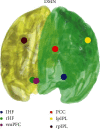Modulation of Working Memory and Resting-State fMRI by tDCS of the Right Frontoparietal Network
- PMID: 34349797
- PMCID: PMC8328716
- DOI: 10.1155/2021/5594305
Modulation of Working Memory and Resting-State fMRI by tDCS of the Right Frontoparietal Network
Abstract
Many cognitive functions, including working memory, are processed within large-scale brain networks. We targeted the right frontoparietal network (FPN) with one session of transcranial direct current stimulation (tDCS) in an attempt to modulate the cognitive speed of a visual working memory task (WMT) in 27 young healthy subjects using a double-blind crossover design. We further explored the neural underpinnings of induced changes by performing resting-state fMRI prior to and immediately after each stimulation session with the main focus on the interaction between a task-positive FPN and a task-negative default mode network (DMN). Twenty minutes of 2 mA anodal tDCS was superior to sham stimulation in terms of cognitive speed manipulation of a subtask with processing of objects and tools in unconventional views (i.e., the higher cognitive load subtask of the offline WMT). This result was linked to the magnitude of resting-state functional connectivity decreases between the stimulated FPN seed and DMN seeds. We provide the first evidence for the action reappraisal mechanism of object and tool processing. Modulation of cognitive speed of the task by tDCS was reflected by FPN-DMN cross-talk changes.
Copyright © 2021 Monika Pupíková et al.
Conflict of interest statement
The authors declare that there is no conflict of interest regarding the publication of this paper.
Figures




References
-
- Fox M. D., Snyder A. Z., Vincent J. L., Corbetta M., Van Essen D. C., Raichle M. E. The human brain is intrinsically organized into dynamic, anticorrelated functional networks. Proceedings of the National Academy of Sciences of the United States of America. 2005;102(27):9673–9678. doi: 10.1073/pnas.0504136102. - DOI - PMC - PubMed
Publication types
MeSH terms
LinkOut - more resources
Full Text Sources

